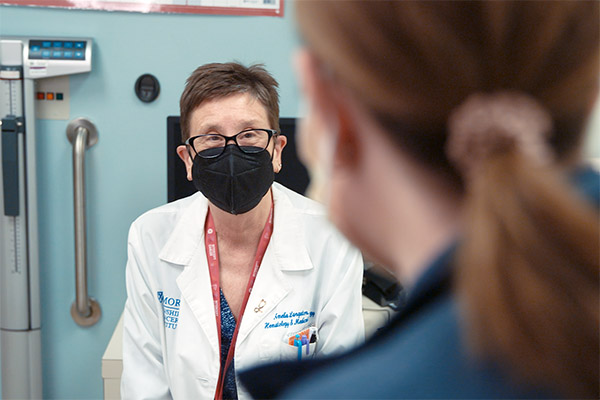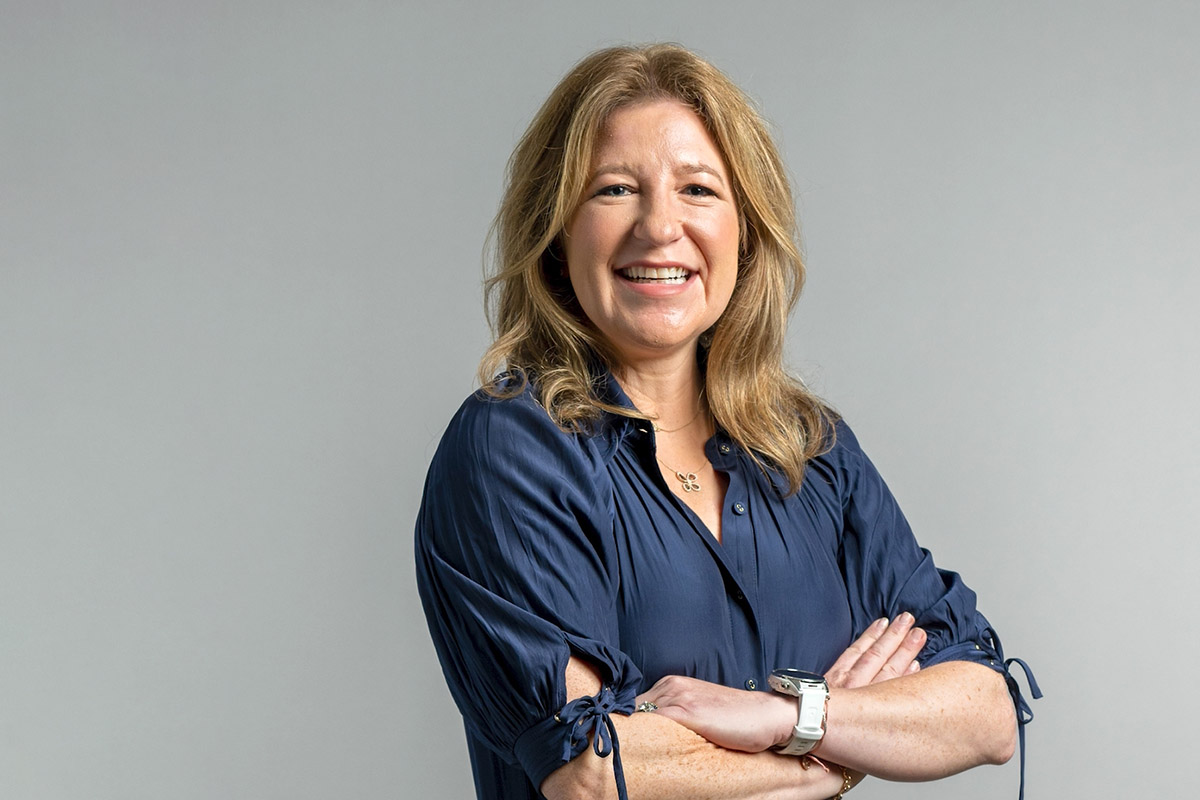I’m lucky to the point of feeling guilty.
Marathoner’s still running after leukemia diagnosis and treatment
Lauren Schlossberg leads an active life. She runs and plays tennis for fun. “I’ve enjoyed running because it’s easy, anywhere you are. All you need is a pair of sneakers and some music. I can even do it without music; that’s how much I enjoy it.”
It was running that made Lauren initially realize something was amiss. “I wasn’t able to run as effortlessly as I had, and the feeling seemed a little more extreme than just age,” she says. She was running in the Publix Half Marathon but was struggling just to breathe. “I had trained, but I really wasn’t sure what was happening. I just couldn’t wait to finish, and when I finished, I felt horrible.”
Lauren pushed herself and powered through it. But she still wasn’t feeling well and was tiring easily. After she and her husband hosted out-of-town family, she dropped her children off at school and went to an urgent care center. Nothing was showing up in any tests there. “Go get some Mucinex,” she was told. That didn’t help.
Feeling even worse the next morning, Lauren decided to go to an emergency room. The ER physician told her that her white blood cells were very high, signaling that she could have HIV/AIDS, mono or cancer. “If it’s a multiple choice,” she said, “can I take mono?’”
At that point, Lauren says, “you just don’t even know what to think.” Her thoughts ran to wondering whether she would live to see her children graduate from high school.
Getting a diagnosis
More tests followed, including a bone marrow biopsy. Eventually it became clear what was happening: Lauren had chronic myeloid leukemia (CML).
CML is also called chronic myelogenous leukemia, chronic granulocytic leukemia and chronic myelocytic leukemia. CML is one of four main types of leukemia. It’s caused by a genetic mutation called the Philadelphia chromosome, which results from a broken and swapped section of chromosomes 9 and 22. Symptoms include fatigue, weight loss, bleeding or bruising easily, pale skin, swollen glands (especially in the neck, armpits and groin) and night sweats.
After sorting out her diagnosis, the next consideration was treatment. “I’m lucky to the point of feeling guilty,” says Lauren, because CML has a very effective treatment.
According to The Leukemia & Lymphoma Society, the introduction of tyrosine kinase inhibitor (TKI) therapy in 2001 has transformed CML from a life-threatening disease to a manageable chronic condition for most patients. People are living longer with CML and experiencing fewer treatment side effects.
“For anyone who had CML prior to that point, it was a death sentence,” Lauren says. “But as a result of all the hard work, all the research, all the people before me who were subjects in clinical trials, this disease has become something that’s manageable.”
“Hitting the jackpot” at Winship

Dr. Langston with Lauren during a follow up.
Lauren and her husband were connected to Winship Cancer Institute of Emory University through an acquaintance. “Before I had my official diagnosis,” Lauren says, “I was set up for an appointment to get seen at Winship, to figure out the plan, manage the medication, get educated some more.”
Lauren considers herself “incredibly lucky” to have had a type of cancer with effective treatment. What’s more, she says, she “hit the jackpot” with her physician at Winship, Amelia A. Langston, MD, director of Winship’s Bone Marrow and Stem Cell Transplant Program. Lauren recalls going into the exam room to meet Langston. “There was a whiteboard, and she drew on it and explained very well to me everything that was happening and what the plan was going to be.”
It wasn’t only Langston’s treatment plan that impressed Lauren. “She was very calm and very encouraging, but not overly encouraging, because we still didn’t know my official diagnosis at that point. Dr. Langston’s demeanor, her calmness and the way she sat down and explained everything to me — like she had nothing else to do — was really comforting. I also like how she was able to then go and access other resources, like the pharmacy department, who could then come in and say, ‘Here’s how we’re going to get your treatments. Here’s the other drugs that it might interfere with. We’re going to make sure that this is all integrated and seamless.”
When Lauren had some reactions to the first medication she was prescribed — vomiting to the point of dehydration — she was able to go to one of Winship's Immediate Care Centers, dedicated to and designed for patients with cancer experiencing symptoms or side effects requiring immediate medical care. There, a medical team specialized in oncology delivers urgent care, diagnostics and treatments that are often unique to patients with cancer.
Lauren says, “It was great to be able to get in there, get an appointment with somebody who is coordinated with your entire cancer care team and get treated, and not have to go over all the things that are going on in your body because of CML.”
Life since cancer

Lauren with her family at a local running event.
Lauren at the time of the publication of this article was counting the months until she reached two years of the disease being “undetectable,” indicating her CML was in remission. “I’m optimistic,” she says, “but there’s still that cloud that’s over my head. What if something doesn’t work? What if I take a supplement that interferes with it?”
An important lesson she learned was not to become overly alarmed by what could turn out to be ordinary kinds of health blips — a stomach virus, for example. “Anytime I get tired,” she says, “I think, ‘Oh, no, is this something?’ I had a stomach virus in February, and I put myself in such a tailspin that I thought I had appendicitis.” The incident showed her that not every illness is serious.
Lauren’s experience with CML also taught her to listen to her body and give herself “a little more grace.” She still runs, though now she’s “constantly analyzing” her heart rate, run time and how she feels compared to her last run. “I still enjoy running,” she says, “and now that it’s become a family affair and everyone beats me — which is exactly what I want — it’s taken on a different form and a different meaning, and it’s helped me.”
Running has also become spiritual for Lauren, in the sense of believing that even cancer has been part of her life for a reason. Last year Lauren and her family ran the Winship 5K to support cancer research. She finds meaning in how her cancer experience brought her to Winship — now feeling a calling “to become a part of this organization in the sense of donations, giving time and anything that I can do to help so that we’re bettering the world.”
Care tailored to your needs
Care for patients with leukemia at Winship includes leading cancer specialists collaborating across disciplines to tailor treatment plans to each patient’s needs; innovative therapies and clinical trials; comprehensive patient and family support services; and a care experience aimed at easing the burden of cancer.

